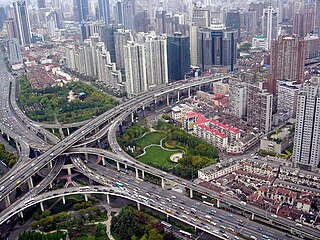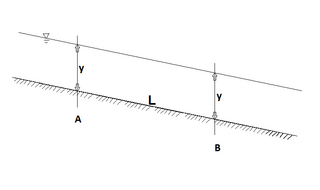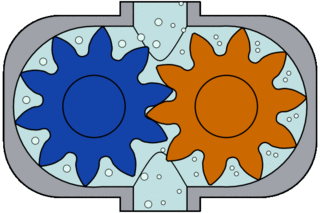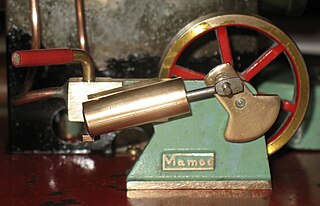Operation
Such a machine may be constructed by mechanically connecting two pistons, each working in a separate cylinder of a different diameter. As the pistons are mechanically linked, their force and stroke length are the same. If the diameters are different, the hydraulic pressure in each cylinder will vary in the same ratio as their areas: the smaller piston giving rise to a higher pressure. As the pressure is inversely proportional to the area, it will be inversely proportional to the square of the diameter.

A piston is a component of reciprocating engines, reciprocating pumps, gas compressors and pneumatic cylinders, among other similar mechanisms. It is the moving component that is contained by a cylinder and is made gas-tight by piston rings. In an engine, its purpose is to transfer force from expanding gas in the cylinder to the crankshaft via a piston rod and/or connecting rod. In a pump, the function is reversed and force is transferred from the crankshaft to the piston for the purpose of compressing or ejecting the fluid in the cylinder. In some engines, the piston also acts as a valve by covering and uncovering ports in the cylinder.

A hydraulic cylinder is a mechanical actuator that is used to give a unidirectional force through a unidirectional stroke. It has many applications, notably in construction equipment, manufacturing machinery, and civil engineering.

In physics, a force is any interaction that, when unopposed, will change the motion of an object. A force can cause an object with mass to change its velocity, i.e., to accelerate. Force can also be described intuitively as a push or a pull. A force has both magnitude and direction, making it a vector quantity. It is measured in the SI unit of newtons and represented by the symbol F.
The working volume of the intensifier is limited by the stroke of the piston. This in turn limits the amount of work that may be done by one stroke of the intensifier. These are not reciprocating machines (i.e. continually running multi-stroke machines) and so their entire work must be carried out by a single stroke. This limits their usefulness somewhat, to machines that can accomplish their task within a single stroke. They are often used where a powerful hydraulic jack is required, but there is insufficient space to fit the cylinder size that would normally be required, for the lifting force necessary and with the available system pressure. Using an intensifier, mounted outside the jack, allows a higher pressure to be obtained and thus a smaller cylinder used for the same lift force. Intensifiers are also used as part of machines such as hydraulic presses, where a higher pressure is required and a suitable supply is already available. [2]

A hydraulic press is a machine press using a hydraulic cylinder to generate a compressive force. It uses the hydraulic equivalent of a mechanical lever, and was also known as a Bramah press after the inventor, Joseph Bramah, of England. He invented and was issued a patent on this press in 1795. As Bramah installed toilets, he studied the existing literature on the motion of fluids and put this knowledge into the development of the press.
Some small intensifiers have been constructed with a stepped piston. This is a double-ended piston, of two different diameters, each end working in a different cylinder. This construction is simple and compact, requiring an overall length little more than twice the stroke. It is also still necessary to provide two seals, one for each piston, and to vent the area between them. A leak of pressure into the volume between the pistons would transform the machine into an effective single piston with equal area on each side, thus defeating the intensifier effect.
A mechanically compact and popular form of intensifier is the concentric cylinder form, as illustrated. [1] In this design, one piston and cylinder are reversed: instead of the large diameter piston driving a smaller piston, it instead drives a smaller moving cylinder that fits over a fixed piston. This design is compact, and again may be made in little over twice the stroke. It has the great advantage though that there is no "piston rod" and the effective distance between the two pistons is short, thus permitting a much lighter construction without risk of bending or jamming.
In the example illustrated, the two pistons are approximately 1:2 ratio in diameter, giving a 1:4 increase in pressure. Note that it is the diameter of the effective piston, i.e. the seal diameter that matters. The cylinders here are relieved beyond the seal and are of greater diameter, for easy running. Although the moving cylinder's bore is around ¾ of the outer diameter, not ½, it is its seal diameter that matters, not its internal clearance bore.
The celebrated mechanical engineer Harry Ricardo began his career by working in his grandfather, Alexander Rendel's, civil engineering practice. [2] At the time they were involved in the construction of bridges in India, which required hydraulic lifting, hoisting and riveting equipment. As the existing transport infrastructure was poor, all plant used on site needed to be lightweight and easily portable. Machines also needed to be connected to their hydraulic power source by flexible tubing, which limited their working pressure to around 500 psi. At this time, modern shipyard equipment was using pressures of up to 2000 psi. This high-pressure equipment was smaller and lighter than the bulkier low-pressure variety, a desirable feature for this construction work. Ricardo's innovation was to specify the use of portable hydraulic intensifiers for these tools, permitting the use of the improved high-pressure form, even where their supply was at low-pressure, through flexible hose. These intensifiers were so successful that eventually several hundred were supplied and used. [2]

Sir Harry Ralph Ricardo was one of the foremost engine designers and researchers in the early years of the development of the internal combustion engine.

Civil engineering is a professional engineering discipline that deals with the design, construction, and maintenance of the physical and naturally built environment, including public works such as roads, bridges, canals, dams, airports, sewerage systems, pipelines, structural components of buildings, and railways.

A rivet is a permanent mechanical fastener. Before being installed, a rivet consists of a smooth cylindrical shaft with a head on one end. The end opposite to the head is called the tail. On installation, the rivet is placed in a punched or drilled hole, and the tail is upset, or bucked, so that it expands to about 1.5 times the original shaft diameter, holding the rivet in place. In other words, pounding creates a new "head" on the other end by smashing the "tail" material flatter, resulting in a rivet that is roughly a dumbbell shape. To distinguish between the two ends of the rivet, the original head is called the factory head and the deformed end is called the shop head or buck-tail.
Inline vs. parallel intensifiers
There are two specialized types of hydraulic intensifier used for water jet cutting. The first and most common is the inline hydraulic intensifier. Oscillating hydraulic pistons are used to compress water to the required pressure levels. The water jet system's cutting head restricts the water flow to generate pressure and direct it onto the workpiece. A holding tank, called a hydraulic accumulator, is used to reduce pressure vibrations at the output end.

A water jet cutter, also known as a water jet or waterjet, is an industrial tool capable of cutting a wide variety of materials using a very high-pressure jet of water, or a mixture of water and an abrasive substance. The term abrasive jet refers specifically to the use of a mixture of water and abrasive to cut hard materials such as metal or granite, while the terms pure waterjet and water-only cutting refer to waterjet cutting without the use of added abrasives, often used for softer materials such as wood or rubber.

Oscillation is the repetitive variation, typically in time, of some measure about a central value or between two or more different states. The term vibration is precisely used to describe mechanical oscillation. Familiar examples of oscillation include a swinging pendulum and alternating current.
A hydraulic accumulator is a pressure storage reservoir in which a non-compressible hydraulic fluid is held under pressure that is applied by an external source. The external source can be a spring, a raised weight, or a compressed gas. An accumulator enables a hydraulic system to cope with extremes of demand using a less powerful pump, to respond more quickly to a temporary demand, and to smooth out pulsations. It is a type of energy storage device.
The more recently developed parallel hydraulic intensifier also uses oscillating pistons to compress water. However, these systems use multiple cylinders that operate in a parallel fashion, ensuring that one cylinder is always in compression mode. This feature minimize the pressure fluctuations that are common with inline designs, and eliminates the need for an accumulator. Efficiency and reliability are also improved. [3]























